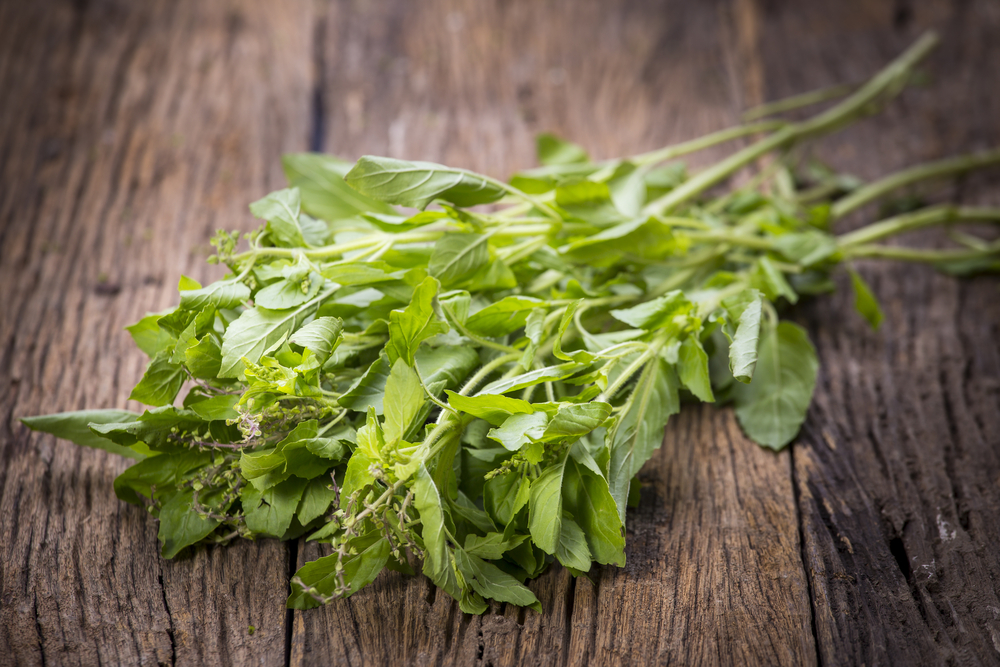The next read is an excerpt from “The Doctor’s Book of Survival Home Remedies”, Chapter: Holy Basil, pages 293-295:
Latin Name: Ocimum sanctum, also known as Ocimum tenuiflorum
Holy basil is an undervalued herb in North America. But in native India people have cherished it for over 5,000 years. This herb is also known as ‘tulsi’, which roughly translates to “the incomparable one”.
This name reflects holy basil’s impressive health benefits. Holy basil is an integral part of Ayurvedic medicine and many homes throughout India grow an honored holy basil plant. They even pray to it every morning and evening. What’s more, it’s said that having a holy basil plant in your home protects your family from evil and it brings peace, harmony, and good luck.
While these claims are difficult to prove, the evidence is mounting that holy basil can address a range of physical, metabolic, chemical, and psychological ailments. It’s even been shown to possess broad-spectrum antimicrobial activity against a range of human and animal pathogens, including antibiotic-resistant organisms.
Holy basil is what’s known as an adaptogen, which is a plant that can help your body adapt to stress by helping regulate your hormonal responses to environmental, physical, and psychological stress. This allows your body systems to function more effectively.
You can use holy basil in cooking similarly to regular sweet basil, although it has a somewhat stronger, more pungent flavor. It also lends itself well to a variety of home remedies.
Conditions Holy Basil Can Remedy
Modern research and traditional Ayurvedic medicine have proven that holy basil can effectively treat or prevent an array of different conditions. One key factor that may make it so powerful is the fact that certain phytochemicals in holy basil are shown to increase antioxidant activity in your body.
Antioxidants help your body by neutralizing free radicals. Free radicals are natural byproducts of your metabolism and exposure to environmental stress, but when you have too many free radicals in your system, they can damage tissues and lead to conditions like cancer, heart disease, and Alzheimer’s disease.
By increasing antioxidant activity, holy basil helps your body clear out free radicals. This allows your body to maintain better balance and to recover from the inevitable stressors you encounter from day to day.
Holy basil has been shown to help alleviate the following conditions:
- Acne
- Asthma
- Cancer
- Colds and Flu
- Depression
- Diabetes
- Digestive Disorders
- Fever
- Headaches
- High Cholesterol
- Inflammation
- Insect Bites
- Kidney Stones
- Lung Disorders
- Mouth Ulcers
- Radiation Toxicity
- Respiratory Disorders
- Skin Disorders
- Stress
How To Grow Holy Basil
Holy basil is a small shrub you can easily grow at home outside or indoors,
with leaves that range from light green to dark purple, depending on the variety. It grows to about 18 inches (46 centimeters) tall and can easily be trimmed to keep it compact. It’s naturally an annual plant, but it can be kept for many seasons as long as you trim off the flowers before they form seeds.
The plants can’t survive frost and do best when night temperatures remain
above 54 degrees Fahrenheit (12 degrees Celsius). If you have a container plant, bring it inside for the night if temperatures drop below that.
Getting Started
Holy basil is easy to start from seed. Your local garden center may also carry holy basil plants in the spring. If you can’t find a plant locally, they can also be bought online year-round. Just make sure the plants or seeds you’re buying are labeled as Ocimum sanctum or O. tenuiflorum. Holy basil is one specific species of basil that goes by either of those two Latin names.
You can sow holy basil seeds directly outside after the risk of frost has passed, or anytime if you live in a frost-free climate. You can also start them indoors 6-8 weeks before your last frost, or anytime if you’re keeping them indoors. Holy basil likes rich, nutritious soil, so whether you’re planting directly in the soil or in a potting mix, make sure it has a good amount of organic matter.
- Keep your seeds moist and they should start to germinate in about 10 days, but can take up to 6 weeks. In the late Spring/early Summer, create or buy a rich, vegan-organic487 potting mix.
- Fill a tray or small seedling pots with this mix, and lightly press seeds into the soil. (If you have some around, spray EM488 on the seeds first to give them a boost.) One seed per six inches of soil or one seed per pot will do. If you can still see the seeds, gently sprinkle a small bit of dirt over the top of them.
- Keep the Tulsi seeds moist and warm until they germinate, which can take anywhere from one to six weeks.
- Like all basils, Tulsi will branch out when pruned correctly. After the first six sets of leaves appear, pinch off the top set of leaves. This action tells the plant to put its energy into branching out instead of reaching higher.
- Water your plant as needed, but do not be afraid to let the soil dry in between watering. Tulsi likes well-draining soil and will not do well if left sitting in water.
- If your plant starts to go to flower, you can either pinch off all the flower tips (so that the plant will put its energy back into growing) or you can allow part of the plant to flower and then go to seed – either way it is better not to let the entire plant go to flower.
It is forbidden to replicate any of the above content without Dr. John Herzog’s consent. However, in order to support the discounts and donations we’re making, we depend on free advertising. The doctor needs your help in sharing this with the world.










































































I love basil!!!!! And medical cannabis is different)))
Okay so after you grow it (good instructions) how do you prepare it for all those medicinal uses? I am sure there are different ways for treatment and prep. Please advise. Thnx.
I’m thinking, i can dry the leaves, crush, then add to smoothies, or use in capsule form.
I’m doing that with moringa now. So need to get my medicinal garden going.
I do natural supplements in my smoothies such as Ashwaganda. Up until a couple months ago I also used Moringa until I read that it does not work well with my thyroid medicine.
Ooh I love this info. I want to make tinctures!!